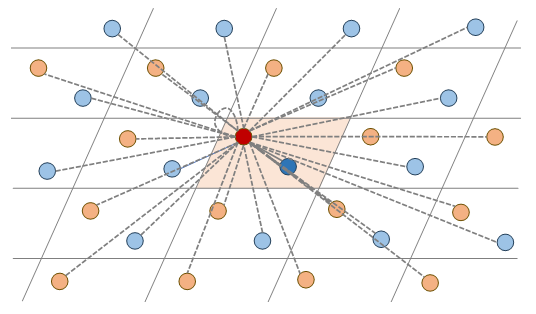Neural structure fields with application to crystal structure autoencoders
Communications Materials 2023TL;DR Express crystal structures as 3D continuous fields for crystal structure prediction
Overview
Representing crystal structures of materials to facilitate determining them via neural networks is crucial for enabling machine-learning applications involving crystal structure estimation. Among these applications, the inverse design of materials can contribute to explore materials with desired properties without relying on luck or serendipity. Here, we propose neural structure fields (NeSF) as an accurate and practical approach for representing crystal structures using neural networks. Inspired by the concepts of vector fields in physics and implicit neural representations in computer vision, the proposed NeSF considers a crystal structure as a continuous field rather than as a discrete set of atoms. Unlike existing grid-based discretized spatial representations, the NeSF overcomes the tradeoff between spatial resolution and computational complexity and can represent any crystal structure. We propose an autoencoder of crystal structures that can recover various crystal structures, such as those of perovskite structure materials and cuprate superconductors. Extensive quantitative results demonstrate the superior performance of the NeSF compared with the existing grid-based approach.
Crystal Structures as Continuous Fields
The crystal structure of an inorganic material is a regular and periodic arrangement of atoms in 3D space. This periodic arrangement is usually described by a minimum repeatable pattern called a unit cell. The atoms in a unit cell have no explicit order, and their quantity varies from one to hundreds in number.
Because ML models generally accept fixed-dimensional and consistently ordered tensors for processing, determining crystal structures via the models is challenging.
To address this problem, we represent a crystal structure as a continuous vector field tied to 3D space, rather than as a discrete set of atoms. The proposed approach, named neural structure fields (NeSF), uses two types of vector fields: position field and species field. These fields implicitly represent the positions and species of the atoms in the unit cell, respectively.

To illustrate the concept of the NeSF, assume that we are given target material information as a fixed-dimensional vector, , and consider the problem of recovering a crystal structure from . Input may specify, for example, information on the crystal structure of a material or some desired criteria for materials to be produced.
The NeSF uses a neural network, , as a vector field on 3D Cartesian coordinates , conditioned on the target material information, :
In the position field, network is trained to output a 3D vector pointing from query point to its nearest atom position in the crystal structure of interest. Thus, we expect output to be . If the position field is ideally trained, we can retrieve position of the nearest atom at any query point as .
Analogously, the species field is trained to output a categorical probability distribution that indicates the species of the nearest atom.
Application to Crystal Autoencoders
As an application of the NeSF, we present an autoencoder of crystal structures. In this autoencoder, crystal structures are embedded into vectors (called latent vectors) via an encoder, and then the NeSF acts as a decoder to recover the input crystal structures from .

Autoencoders are typically used to learn latent vector representations of data via self-supervised learning, in which the input data can supervise the learning via a reconstruction loss.
Benchmark
The NeSF-based autoencoder outperforms an existing voxel-based method, ICSG3D (Court et al., 2020), in reconstruction accuracies.


Interpolation of Materials
Interestingly, the learned latent space with the NeSF enables us to produce interpolated crystal structures between a pair of materials.

Latent space interpolation from ZnS to CdS

Latent space interpolation from MgO to NaCl
Contact
Citation
@article{chiba2023nesf,
author = {Naoya Chiba and
Yuta Suzuki and
Tatsunori Taniai and
Ryo Igarashi and
Yoshitaka Ushiku and
Kotaro Saito and
Kanta Ono
},
title = {Neural structure fields with application to crystal structure autoencoders},
journal = {Communications Materials},
volume = {4},
number = {1},
pages = {106},
year = {2023},
month = {12},
day = {12},
doi = {10.1038/s43246-023-00432-w}
}

